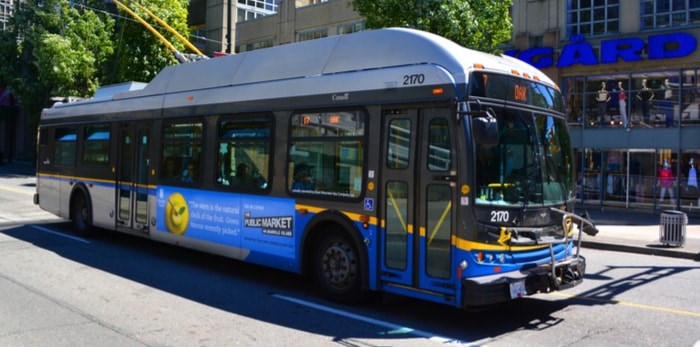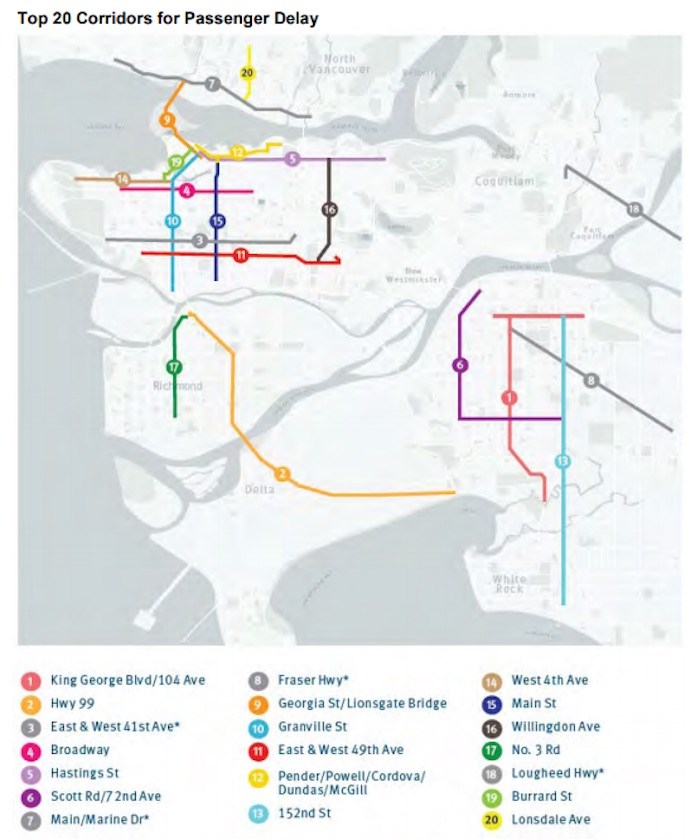 TransLink bus in Vancouver (meunierd / Shutterstock.com)
TransLink bus in Vancouver (meunierd / Shutterstock.com)
It takes much longer to travel by bus in Metro Vancouver today than it did five years ago, which is increasing costs to run the bus system.
According to a TransLink report released Monday, 80 per cent of Metro Vancouver bus routes are slower than they were half a decade ago, largely due to increased traffic congestion on the roads and a “lack of sufficient bus priority.”
The report notes that for transit riders, this means longer ride times and longer waits, as well as more overcrowding, all of which reduces the “attractiveness” of commuting by transit.
2018 saw record-breaking ridership, with 437.4 million boardings. And over the last three years, total transit ridership has increased by 17 per cent, and total bus ridership by 14 per cent.
The report compiled a list of the top 20 corridors for passenger delays, with King George Boulevard / 104 Avenue in Surrey taking the top spot, followed by Highway 99, which passes through Richmond and Delta.
In Vancouver, 41st Ave east and west ranks third, Broadway ranks fourth, and Hasting Street rounds out the top five of the 20 worst corridors for passenger delay.
 Top 20 routes for passenger delay. Image via TransLink
Top 20 routes for passenger delay. Image via TransLink
This slower service also costs TransLink money.
The transit authority estimates road delays are costing the company more than $75 million per year, 12 per cent of Coast Mountain Bus Company’s (CMBC) total operating costs.
Operator breaks and extra time needed to ensure on-time departures increased operating costs by another 16 per cent. As bus travel times become more irregular, “recovery time” must be increased, according to the report.
And an additional $2.5 to $5 million goes towards adjusting transit schedules each quarter to maintain on-time bus performance.
More buses and drivers are needed to keep buses at their scheduled frequency. For example, if a bus route previously ran every 10 minutes and took a total time of 50 minutes to complete, it required five buses.
But because it takes buses longer to run their routes, more buses are needed to maintain the 10-minute frequency.
“Bus delay due to congestion is a major problem for TransLink’s customers, budgets and our ability to expand,” reads the report. “However, it is a problem for which many solutions exist, as has been demonstrated locally and globally.”
The report identifies a number of strategies to help curb road congestion and improve transit times, most of which would be up to municipalities or the provincial government to implement.
“They [municipalities and the Ministry of Transportation and Infrastructure] control all tools related to traffic controls (e.g. turn restrictions, signal timing and prioritization), roadway infrastructure (e.g., bus bulbs), curb management (e.g. parking removal) and transit lane designations (e.g. bus or HOV lanes),” reads the report.
The four worst routes will benefit from the new RapidBus routes that TransLink is rolling out next year.
The report will be presented to the Metro Vancouver Mayors’ Council on Friday.
With additional reporting from Vancouver Is Awesome



